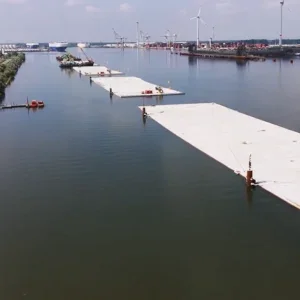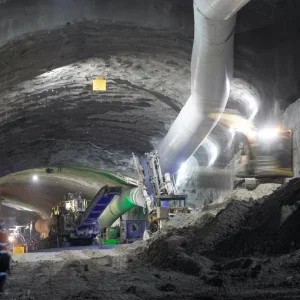Start from Paris and travel directly east. You will, in turn, pass through Strasburg, Stuttgart, Munich, Vienna, Bratislava and Budapest. Those great European cities lie on an almost straight line; and there is indeed a line, a railway line, between them, though it is not always terribly straight, or fast, or with convenient through connections. That is all about to change.
The Magistrale for Europe is a high speed, unified rail link that will run 1,500km from Paris to Budapest. It was conceived by the EU in 1995, and is due for completion this year.
It will link 34 million people in five countries. Its benefits are many: economic, political and cultural integration of western and eastern Europe are among the most obvious.
Most of it runs along existing routes that have been or are being upgraded for high-speed running. A key part, however, is the section between Stuttgart and Ulm, in the southern German state of Baden-Württemberg, almost in the centre of the line in the Jura Mountains or Swabian Alps.
Passing through the state capital Stuttgart, the Magistrale forms part of the Stuttgart 21 project, which is a total revamping of the city’s rail system. Stuttgart’s main railway station has until now been a terminus. The Magistrale and Stuttgart 21 will transform it into a through station. The existing familiar and loved building is being retained, but will no longer be used for trains. New lines and platforms for the through route are being built beneath it. Existing rail lines that cut the city in two are being put into tunnels, releasing 100Ha of land for housing and green space in the very centre of the city.
Around 20km south east of Stuttgart lies Wendlingen. The Wendlingen-Ulm high-speed rail line is the longest new section of the Magistrale at 60km long with around half running through tunnels. Gradients are steep, the rock (and the engineering) is hard, the project has been controversial both socially and in terms of engineering. The tunnels are twin-bore throughout and have been excavated through complex Jurassic geology. When completed, they will halve the journey time between Stuttgart and Ulm to just 30 minutes, with planned speeds of up to 250km/hr. The standard gradient is 2.5% but it peaks at 3.5% in the short through exit of the Albabstreig Tunnel at Ulm station.
The major tunnels between Stuttgart and Ulm are, from west to east, the Filder, the Albvorland and the Bossler. Breakthrough for the Albvorland came in late October 2019, completing the tunnelling work. Altogether some 50km have been bored in five years of tunnelling.
Filder Tunnel
The first of the tunnels, the Filder, is 9.5km long and takes the line south and east out of Stuttgart city station. Stuttgart itself is located in a narrow valley. The Filder tunnel connects the main station to the Filder region, a rolling plateau some 155m higher than the city. En route it passes under suburbs, curving to avoid various infrastructures, and climbs from 230m asl to 385m asl at a gradient of 1.6%. Near the beginning of the tunnel, its roof is just a few metres under the surface but this figure rapidly increases to around 220m of rock and soil cover. At 30m apart, the twin tunnels are linked by safety refuges every 500m.
The Filder tunnel is divided into two sections of differing geology – a lower section (near the city) and an upper one. At around 4km long, the upper section runs through sandstone with marls and clays, but the lower section burrows through unleached gypsum Keuper, the predominant rock locally.
Excavation began in autumn 2014 using a single Herrenknecht convertible multi-mode TBM of 10.82m diameter. It started from the Filder portal on the plane above Stuttgart, excavating the eastern tunnel of the upper section tunnelling towards Stuttgart station. All the excavated muck was taken out though the launch portal, saving thousands of truck journeys through the city and its environs.
Excavation was in closed mode with muck removal achieved by screw conveyor. After 4km, where the geology changes, tunnelling was paused and the TBM taken apart. Disassembly was complex: since the shield diameter was 10.82m and a tunnel inner diameter was only 9.6m it called for precise logistical planning. The disassembled TBM was transported back to the launch portal, where it was reassembled to start excavating the western tunnel through the same geology and in the same operating mode.
When the western portion of this tunnel had been dug and the Keuper geology began, the TBM changed to open mode and continued tunnelling through the new geological conditions, towards Stuttgart station. Now, muck extraction was achieved by belt conveyor.
The contractors were Atcost21, a joint venture of Porr Deutschland, G. Hinteregger & Söhne, Baugesellschaft, Östu-Stettin Hoch-und Tiefbau, and Swietelsky Baugesellschaft. Navigation was achieved using a system from Bruschsal-based firm VMT.
In July 2018, the TBM reached its destination, an underground cavern just outside the new underground Stuttgart main station. There one of the most complex operations of the entire project was undertaken. The TBM, all 120m of it, had to be turned through 180 degrees and moved 30m sideways to begin the fourth and last part of its excavation – the remaining section of the eastern tunnel back towards the geological transition point.
The first stage of this difficult turnaround was to separate the 1,400t machine from its six back-ups. Then it was placed on a sled resting on cushions filled with nitrogen. Steel plates were laid out on the floor of the cavern for support; the machine on its cushions was steered through a tight curve, rotated on its axis and maneuvered sideways to its required position.
The backups had also to be moved from the western to the eastern tube. They were placed in turn onto self-propelled modular transporters and moved into position one by one. Once lined up behind the TBM in a section of tunnel that had been excavated conventionally, the whole machine was re-assembled. The backups were bolted back into place and the countless hydraulic and electric lines were reconnected for the whole machine to start excavating again.
“Everything went smoothly, but it wasn’t something you do every day,” said Oliver Boiger, head of field service at Herrenknecht. “Such an about-turn underground with a TBM of this size is absolutely exceptional,” said Dr Martin Herrenknecht, owner of the company, saluting the site crew. “This shows what extraordinary technical feats are being achieved during the construction work on the Filder Tunnel.”
The TBM recommenced its dig back towards the geological change point and the termination of the first tunnel it had dug. There it was once again dismantled and carried out to the portal.
A total of 54,000 segments of 10.5m o.d. were used to line the tunnel, each ring comprising six segments plus key. Grouting, however, was not simple. The unleached gypsum Keuper of the lower tunnel consists largely of swellable anhydrite. When anhydrite comes into contact with water its volume increases by more than 60%. This results in huge swelling pressures which could lift the tunnel and damage buildings and infrastructure.
For this reason, using water in these sensitive zones was expressly prohibited. The tunnelling, in open-shield mode, used no water, but the grout infill between the lining rings and the soil presented a major problem. A specific formula was needed for a grout that would reliably remove the risk of swelling and ground lift. Contractor Atcost 21 worked with construction chemical specialist MC-Bauchemie to find one.
The bespoke solution was a geopolymer that combined the features of single- and two-component grouts with the flexible use of an activator. The basis was a modified two-component backfill grout of a nonreactive aggregate; blast furnace slag and fly ash were mixed in as binding agents. An activator was added to initiate the solidification reaction. The grout also contained complex phosphates which influence the solution equilibrium of the anyhdrite in such a way that swelling is inhibited.
Lab trials proved the system’s potential but the project was so sensitive that independent commercial and university analyses were commissioned, lasting over two years, to ensure its suitability. The tests included large-scale trials under in-practice conditions on the actual construction site. The modified two component mortar compound was patented under the name MC-Montan Grout AA 03. MC-Bauchemie describe it as showing ‘optimum bedding properties with high sulphate resistance that provides the tunnel tube with true durability.’ The tunnel builders found that the non-reactive starter aggregate gave them an exceptionally-long open time for application, which in turn gave them maximum operational flexibility. The new cementless annular-gap grout has proved so successful that it has been in great demand worldwide ever since.
Albvorland Tunnel
The next major bore along the route was the 8km twin-bore Albvorland tunnel running through layers of black Jura with 65m of overburden. The contractor was Swiss-based Implenia. In contrast to the Filder, the twin bores were dug using two TBMs rather than one so as to keep to a demanding timescale. The schedule required that both machines be assembled at the jobsite simultaneously, and in the same narrow launch shaft at the tunnel’s eastern portal near Kirchheim unter Teck. Each machine had a diameter of 10.82m and there was only a few metres of clearance between them. A team from Herrenknecht did the assembly. Units were gradually pre-assembled above ground in the site equipment area then lowered into the launch shaft for final assembly.
Excavation began in January 2018. At an average 186m per week, breakthrough came on the northern tunnel in August 2019 and in the slightly longer southern tube in October. Around 60,000 lining segments of 10.5m o.d and 2m width were produced and stored at the tunnel portal. “Even after the production of over 54,000 segments, the moulds for the Albvorland Tunnel are in such good condition that you could build another tunnel” said Roland Steindl of Implenia.
Bossler Tunnel
Right from the start, the project attracted controversy which was particularly intense when it came to the Bossler Tunnel. The Bossler carries the line 8.8km through most of the ascent through the Swabian Jura. It begins at the municipality of Aichelberg, climbs through the 785m-high Bossler mountain in a straight line gaining 213m in height at a mean gradient of 2.5% with a maximum overburden of 280m; it emerges on the other side of the mountain directly onto a new bridge, 485m long and 85m high, that spectacularly spans the Filstal valley in Mulhausen district. On the other side of the bridge, the line enters into another tunnel, the Steinbühl.
The original tender documents, prepared by Deutsche Bahn, had specified that the Bossler and parts of the Filder tunnels were to be excavated conventionally using NATM and shotcrete. It was believed that the geology of the Bossler, of brown Jurassic (argillite and sandstone) and white Jurassic (marl and limestone) was too unstable for excavation by TBM.
Close by to the route in Baden-Württemberg is the Herrenknecht HQ. There was intense public discussion, and eventually a public vote in the state, over whether the Wendlingen-Ulm line should be built at all. To many, including company owner Dr Martin Herrenknecht, it seemed unthinkable not to consider a mechanised tunnelling solution for such an important project – one that was right on his doorstep. He believed that TBM technology was quite capable of constructing the tunnel and that using TBMs could save €70m-100m over the originally tendered conventional method; he argued the case strongly and publicly. TBM excavation soon became included in the political debate that surrounded the project.
Further research, from several different sources and viewpoints, showed that excavation by TBM was indeed feasible over at least part of the tunnels. Winifried Kretschmann, Minister-President of Baden-Württemberg and the first member of the Green party to hold such an office in Germany, on a visit to the Herrenknecht factory supported the call for tenders that did not commit bidders to a specific construction method.
“We need to be open with regard to technology – that way the technically best and most economical solution is the one that is chosen” he said. He was also drawn to family-run businesses like Herrenknecht: “You always feel that special philosophy: they are engineer driven, it’s about the product and the technology, not just about profit.”
Deutsche Bahn reconsidered its position, the tenders were revised to allow TBMs to be used, and the Württemberg public voted in favour of the project. The contract was awarded to the ARGE ATA joint venture. The TBM, named Kätchen, began digging the first of the two parallel tubes of the Bossler at the Aichelberg northwest portal early in 2015.
Kätchen is an EPB shield machine of 11.34m diameter with 4,550kW drive power. Planned excavation rates were 15-20m/day. One kilometer into the dig, the machine encountered an unexpected section of very dry rock which allowed faster rates of around 30m/day – in one case, the distance achieved was 38m. In fact, the speed increase was so considerable that in July and August 2015 the advance was halted for five weeks to convert the muck-removal and other logistics to the higher driving speed. Breakthrough on the first tube was achieved in September 2015.
The TBM was disassembled, taken back to the starting point, and in April 2017 started work on the second tube. Breakthrough was achieved in early June 2018. In the end, the TBM had excavated nearly 7.8km in the first tube, and 8.8km in the second – almost the entire tunnel distance, leaving only very short distances for conventional excavation and the cost saving estimates proved well justified.
A total 60,000 lining segments of 2m width were installed in the twin tunnels in a six-plus-key configuration. They were cast using a carousel system with five curing lines and vacuum lifting in a purpose-built facility 1.6km from the Aichelberg portal and transported over a temporary road. Maximum daily output was 117 segments.
The huge tunnelling effort over five years has meant that the scheduled opening date of late 2020 can be achieved. It is estimated that 10 million passengers a year will use the line. The population of Europe is some 750 million.
That makes for quite an impressive proportion who will experience the new tunnels on the Magistrale line.







